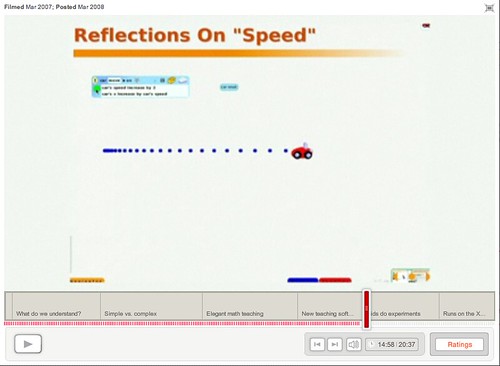Alan Kay's Talk at TED
There are certain events that are just so exciting that I feel compelled to blog about them immediately after I experience it. This is one such event.Alan Kay recently gave at talk at TED. You can view his video from here. Like all TED talks, it's about 20 minutes long so it's short and straight to the point. The rest of my post will make references to the video, so reading it without watching the video might not make much sense.
Unsurprisingly, in the video, Kay demonstrated the canonical moving car example for Etoys. The moving car demo is something that most people familiar with Squeak would have seen. It's really simple but it lets kids experience programming in a fun interactive way. Unfortunately, this is something that most modern languages have failed to enable. After all, which is more fun: printing text to the screen or watching your creation actually move on screen?
However, the second part of Kay's demo was even more interesting. He shows what you can do to help illustrate some simple math and physics properties in an insightful manner. It uses all the features of Etoys (or maybe the full Squeak implementation) to let students experiment by themselves.

Experimenting with this would have been so much cleaner than using a tape meter. It's actually even cooler when you watch the animation or code it up yourself in Etoys.
For instance (and this was something that impressed me), you could design a simple car that drop dots along as it moved. So, a car that is accelerating will be dropping dots further and further apart from one another. This is basically the same idea as using a tape meter. However, the animation of the car moving and dropping dots seem so much cleaner to me. You can easily illustrate the concept of velocity and acceleration without having to talk about friction, etc. Something that is unavoidable with a real experiment. This helps especially when you are teaching a younger audience about the basic principles of motion.
Toward the end of the talk Kay showed an example running on the OLPC. So I was curious whether all courseware on the OLPC will be interactive or whether they will be like normal textbooks only in digital format. Either way, it's already hard enough to actually get good content onto the OLPC. As far as I know, there is no group dedicated to creating content for the OLPC yet.
However, I was able to find a couple of interactive learning environments at OLPC Courseware Review but, from the list, it seems that Dr. Geo II is the only one that has been ported to run on the OLPC. It would be interesting to see if there is a Google Summer of Code project for creating/porting an existing interactive learning environment to the OLPC.
Incidentally I was reading "A Mathematician's Lament" by Paul Lockhart which also talks about how to revamp the current K-12 mathematics education. The paper is available from here. Basically, Lockhart says that there is not enough experimentation with math going on in the class rooms. And that most of math is rote memorization with little appreciation for the beauty of math.
The math education back in Malaysia is not much better either. In school, the teachers are more interested in finishing the syllabus. So students either get-it in school or have to rely on paid tutors to teach it to them. There's very little appreciation on the derivation of the proofs of math. Either the derivation is skipped entirely while teaching or it follows the route of the boring derivation on the board that doesn't engage students.
Tweetcomments powered by Disqus